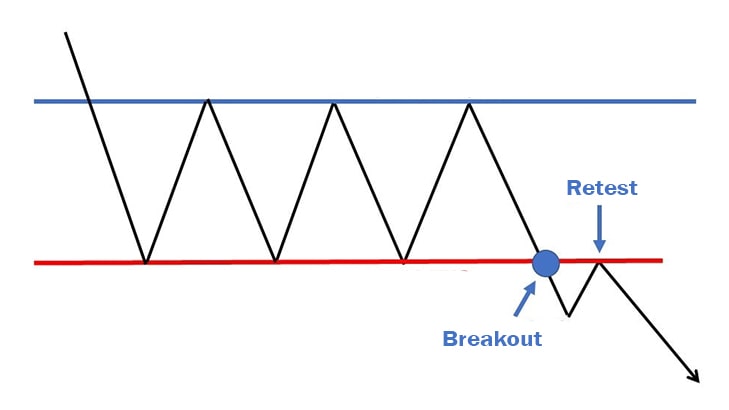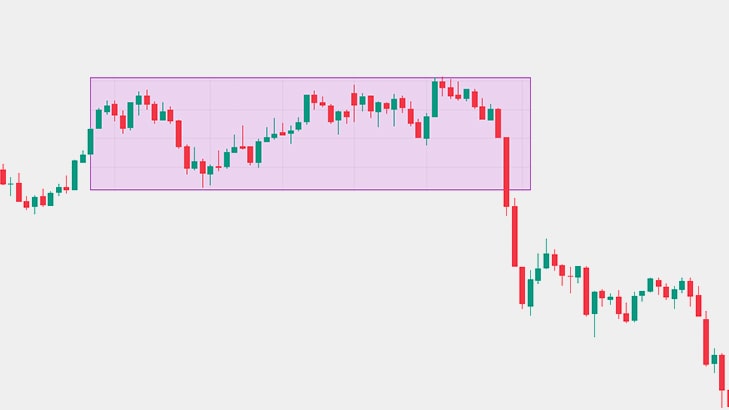
A bearish rectangle chart pattern is a technical analysis pattern observed in financial markets, particularly in stock trading. It’s characterized by a consolidation phase after a downtrend, forming a rectangle shape on the price chart.
Here’s a breakdown of the bearish rectangle pattern:
Formation:
- The pattern typically occurs after a prolonged downward trend in the price of an asset.
- During the consolidation phase, the price trades within a defined range, with relatively equal highs and lows. This creates horizontal parallel lines, resembling a rectangle.
Key Features:
- Parallel Lines: The upper line of the rectangle represents resistance, where sellers are actively pushing the price down. The lower line represents support, where buyers are stepping in to prevent further declines.
- Equal Highs and Lows: The highs and lows within the rectangle are relatively equal, indicating a period of consolidation and indecision in the market.
Significance:
- The bearish rectangle suggests that despite the temporary pause in the downtrend, selling pressure remains dominant.
- It reflects a period of market indecision, with neither buyers nor sellers able to gain control.
- Traders interpret the pattern as a continuation signal, indicating that the downtrend is likely to resume once the consolidation phase is over.
Trading Strategy:
- Entry: Traders often wait for a breakdown below the support level (lower line of the rectangle) to initiate short positions or sell orders.
- Confirmation: A valid breakdown should be accompanied by increased trading volume, signaling strong selling pressure.
- Stop-Loss: Stop-loss orders are typically placed above the resistance level (upper line of the rectangle) to manage risk in case of a false breakout or sudden reversal.
- Target Price: The target price for the bearish rectangle pattern is often estimated by measuring the height of the rectangle and projecting it downward from the breakout point. This provides a potential downside target for profit-taking.
As with any technical analysis pattern, traders should use the bearish rectangle in conjunction with other indicators and analysis techniques for confirmation and risk management. False breakouts and market volatility can impact the reliability of the pattern, so prudent trading strategies are essential.

एक मंदी आयत चार्ट पैटर्न एक तकनीकी विश्लेषण पैटर्न है जो वित्तीय बाजारों में देखा जाता है, खासकर स्टॉक ट्रेडिंग में। यह डाउनट्रेंड के बाद एक समेकन चरण की विशेषता है, जो मूल्य चार्ट पर एक आयताकार आकार बनाता है।
यहां मंदी के आयत पैटर्न का विवरण दिया गया है:
गठन:
- यह पैटर्न आम तौर पर किसी परिसंपत्ति की कीमत में लंबे समय तक गिरावट के बाद होता है।
- समेकन चरण के दौरान, कीमत अपेक्षाकृत समान उतार-चढ़ाव के साथ एक परिभाषित सीमा के भीतर कारोबार करती है। यह एक आयत के सदृश क्षैतिज समानांतर रेखाएँ बनाता है।
प्रमुख विशेषताऐं:
- समानांतर रेखाएँ: आयत की ऊपरी रेखा प्रतिरोध का प्रतिनिधित्व करती है, जहाँ विक्रेता सक्रिय रूप से कीमत को नीचे धकेल रहे हैं। निचली रेखा समर्थन का प्रतिनिधित्व करती है, जहां खरीदार आगे की गिरावट को रोकने के लिए कदम उठा रहे हैं।
- समान उच्च और निम्न: आयत के भीतर उच्च और निम्न अपेक्षाकृत समान हैं, जो बाजार में समेकन और अनिर्णय की अवधि का संकेत देते हैं।
महत्व:
- मंदी का आयत बताता है कि डाउनट्रेंड में अस्थायी ठहराव के बावजूद, बिकवाली का दबाव हावी बना हुआ है।
- यह बाजार के अनिर्णय के दौर को दर्शाता है, जिसमें न तो खरीदार और न ही विक्रेता नियंत्रण हासिल करने में सक्षम हैं।
व्यापारी पैटर्न की व्याख्या एक निरंतरता संकेत के रूप में करते हैं, जो दर्शाता है कि समेकन चरण समाप्त होने के बाद डाउनट्रेंड फिर से शुरू होने की संभावना है।
ट्रेडिंग रणनीति:
प्रवेश: व्यापारी अक्सर शॉर्ट पोजीशन शुरू करने या ऑर्डर बेचने के लिए समर्थन स्तर (आयत की निचली रेखा) के नीचे टूटने का इंतजार करते हैं।
पुष्टिकरण: एक वैध ब्रेकडाउन के साथ ट्रेडिंग वॉल्यूम में वृद्धि होनी चाहिए, जो मजबूत बिक्री दबाव का संकेत देता है।
स्टॉप-लॉस: गलत ब्रेकआउट या अचानक उलट होने की स्थिति में जोखिम का प्रबंधन करने के लिए स्टॉप-लॉस ऑर्डर आमतौर पर प्रतिरोध स्तर (आयत की ऊपरी रेखा) से ऊपर रखा जाता है।
लक्ष्य मूल्य: मंदी के आयत पैटर्न के लिए लक्ष्य मूल्य का अनुमान अक्सर आयत की ऊंचाई को मापकर और ब्रेकआउट बिंदु से नीचे की ओर प्रक्षेपित करके लगाया जाता है। यह लाभ लेने के लिए संभावित नकारात्मक लक्ष्य प्रदान करता है।
किसी भी तकनीकी विश्लेषण पैटर्न की तरह, व्यापारियों को पुष्टि और जोखिम प्रबंधन के लिए अन्य संकेतकों और विश्लेषण तकनीकों के साथ मंदी के आयत का उपयोग करना चाहिए। गलत ब्रेकआउट और बाज़ार की अस्थिरता पैटर्न की विश्वसनीयता को प्रभावित कर सकती है, इसलिए विवेकपूर्ण ट्रेडिंग रणनीतियाँ आवश्यक हैं।







